Review and photos by Bokisaurus
Part 1 of 4 – Large Play visions Prehistoric mammals
This will be a series of four reviews. I decided that each of the figures in the set warrants their own review instead of combined into one. I will also cover the mini version that was from a separate set of 8 figures. So, for the next few installments, I will try and post one from this set in-between others just to break it up a bit.Enjoy.
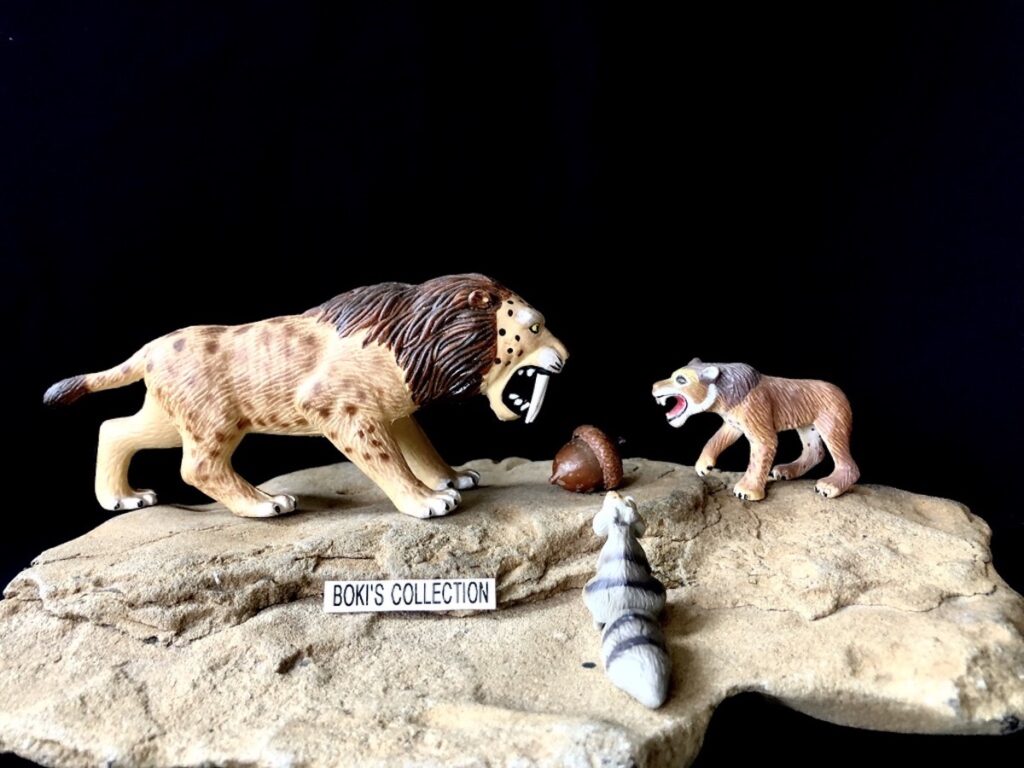
Play visions released various sets of prehistoric animals in the late 1990’s that were based on or heavily inspired by the illustrations from the 1988 book The MacMillan Encyclopedia of Dinosaurs and Prehistoric Animals. Thier scarcity and age have made some of them one of the most coveted and rare prehistoric figures despite their stylized and not always accurate depiction of the animals.
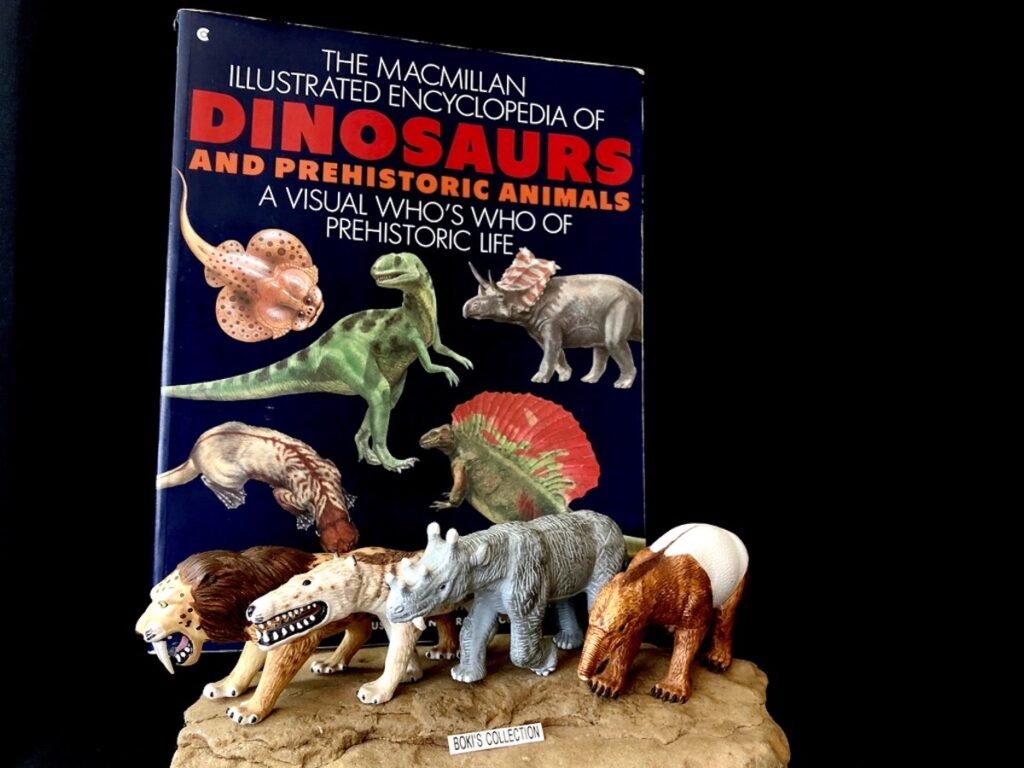
The set that we will review are the large prehistoric mammals that contained only four figures unlike the smaller set that came with eight.These were the largest of the non-dinosaur figures from this series. the other coveted and rare sets are the prehistoric amphibians, marine reptiles, and prehistoric mammals, all of them in small size.
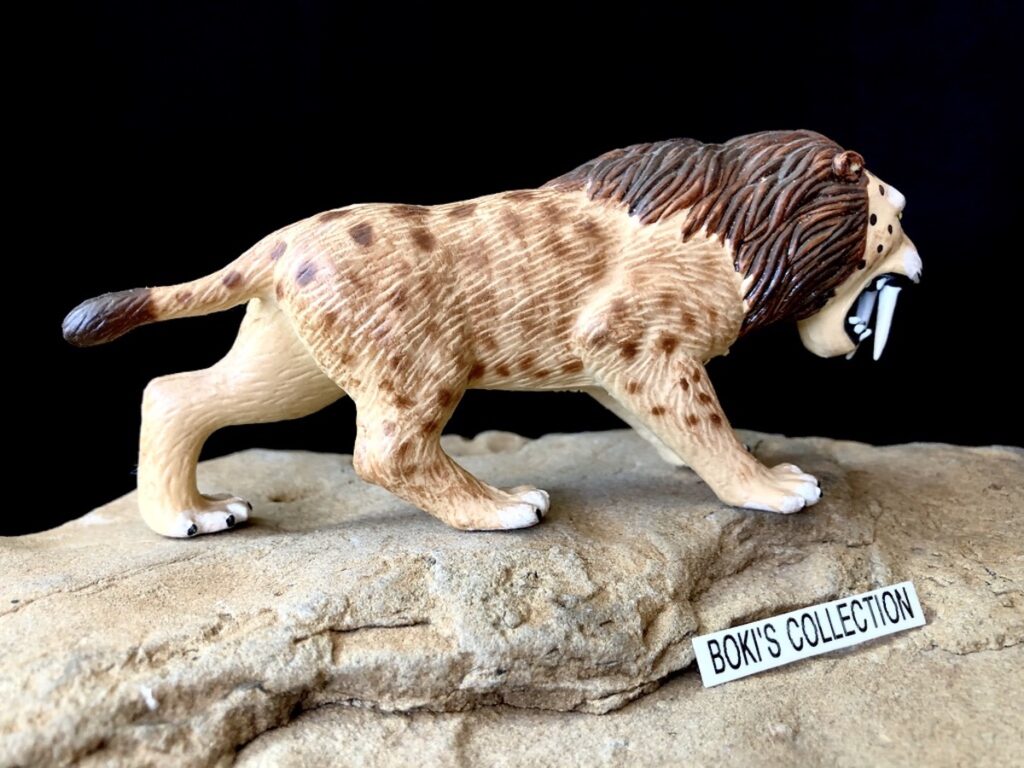
I originally became aware of the set way back in the late 1990’s, way before I started to seriously collect prehistoric figures and joining the forum. Back then, I was not even that interested in prehistoric mammals and mostly only collecting ceratopsians and sauropod figures.Back then, there was not that many options so I was collecting anything I can find related to these two groups.
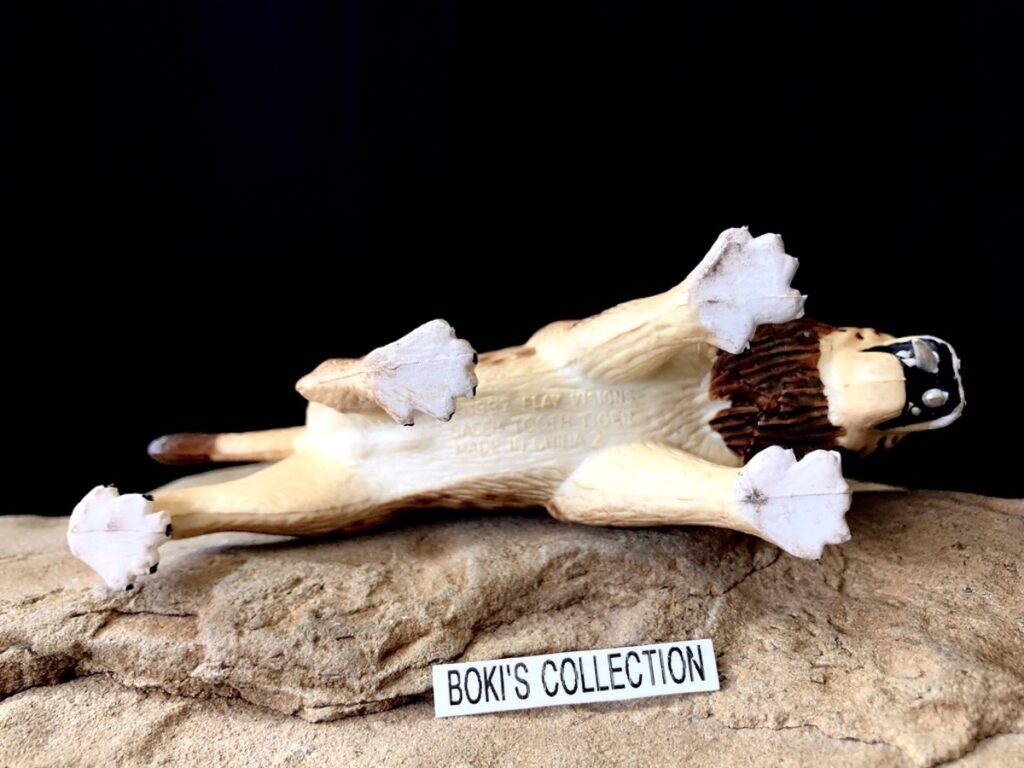
In one of my hunting expeditions, I came across a few of these large prehistoric mammal figures in an art supply store. They were odd looking and really caught my eyes. In those days I was not familiar with many prehistoric mammals that when I decided to buy a couple of these figures, I went for the well-known Smilodon and Andrewsarchus. I figured with my limited fund, I can always go back and purchase the other two really weird ones. I never made it back to the store but that story is for their next reviews.

So, let’s start with the most famous animal in the set, the mighty Smilodon.Being such a well known animal, and with lots of reviews already written about it, I will bypass a lot of its natural history and jump right into the toy itself.Smilodon, thanks to the exquisite fossil preservation from the La Brea Tar Pits, is one of the most complete, best preserved, and well-studied prehistoric animals.

It’s impressive and enormous canines made them one of the most famous prehistoric mammals and as a testament to this popularity, almost all the major toy brands, past and present, have at least one in their collection. As a result, there are plenty of Smilodon figures out there, they rival Tyrannosaurus rex and triceratops in ubiquitous in the toy market. In fact, some of the first and earliest prehistoric animal figures were Smilodon.
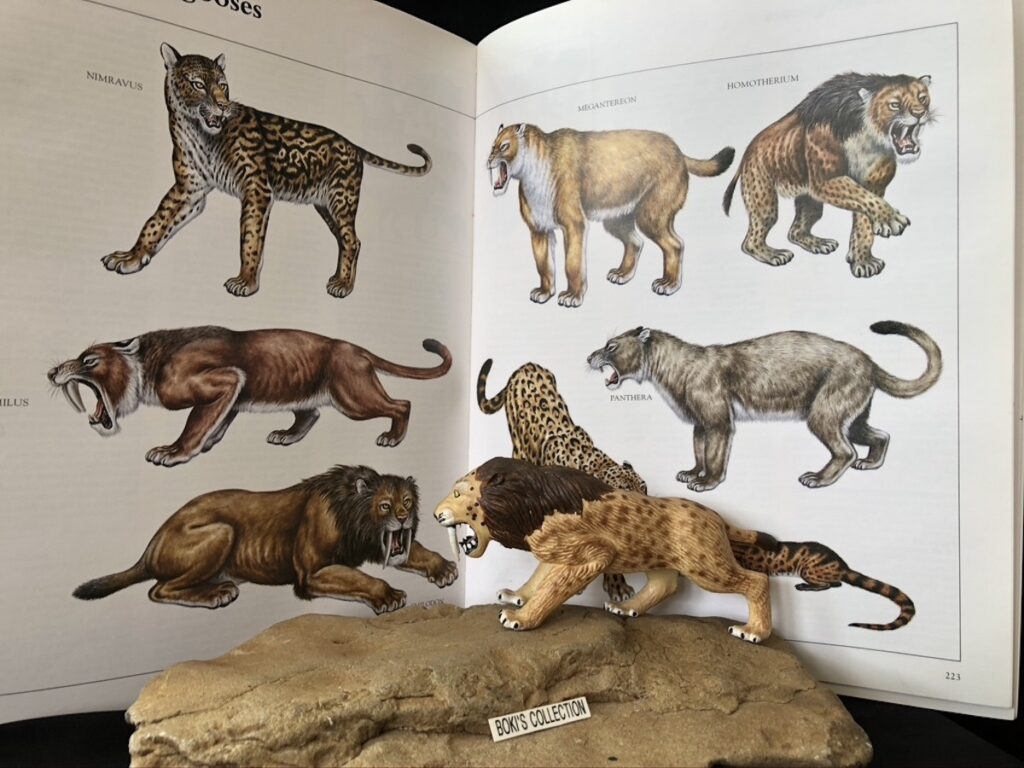
As I mentioned, the Play visions figures are heavily inspired by the illustration from the book, almost all of them are exact duplicate in 3D form. The Smilodon however is an exception. While most of the figures are almost exact down to the pose, this bad boy seems to be a combination of two or even three different illustrations of big cats. Looking at the book pictures, you can see that the overall design is somewhat based on the pictured Smilodon.
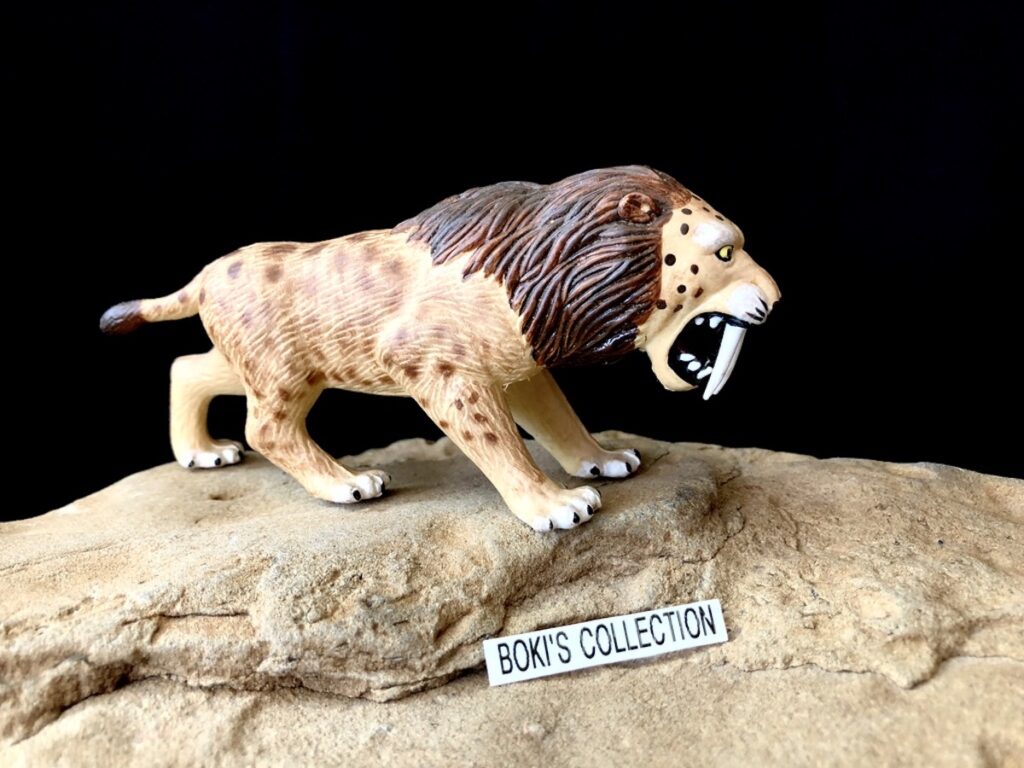
But as you can see, there are many different cats and other animals on the page and one of them, Homotherium, also looks like the figure, in fact it looks closer, more on that later.The figure is posed in an active aggressive pose. Its body is lowered to the ground (although not like the Smilodon illustration) and front legs firmly planted straight down on the ground. The two back legs pushing with one stretched out while the other is directly under. Proportion wise, the body looks similar to a lion. There are enough details on the body such as the fur, but otherwise , it’s a simple sculpt with an overall basic brown colors.
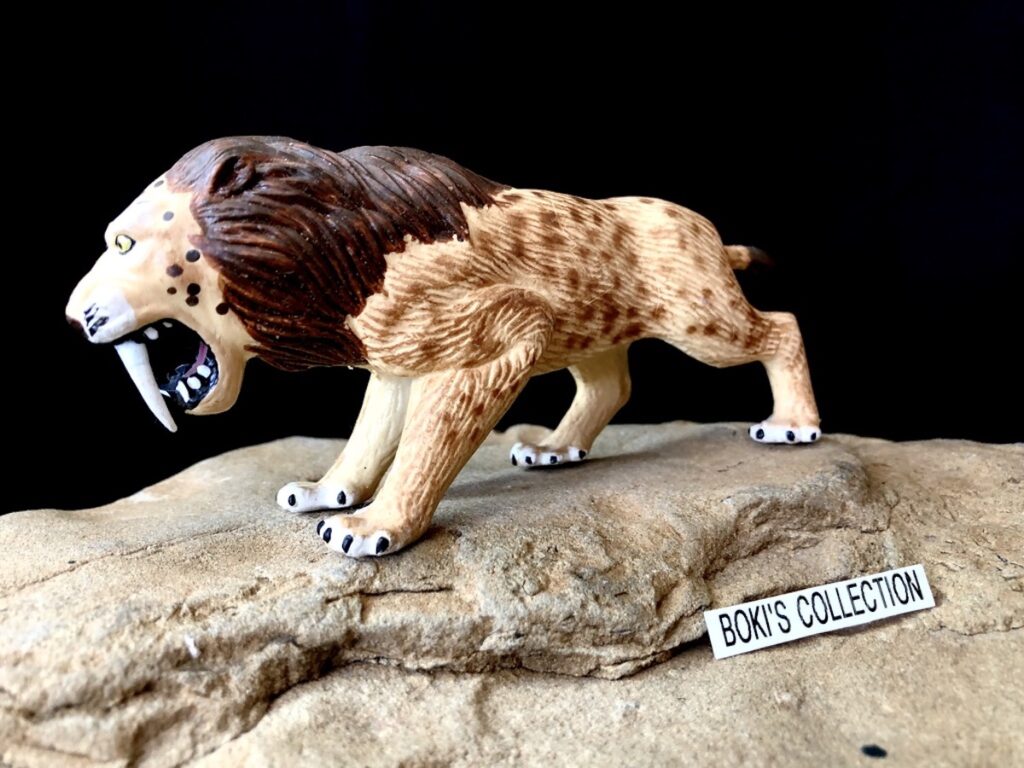
The head is big and its mouth is open (of course) in an aggressive snarl with its formidable long canines and teeth all fully exposed.To add to its aggressive stance, the ears also seems to be pulled back. The eyes, painted yellow, are big and almost looks like they are bulging out in rage or puzzlement. It has a long dark brown mane that starts just before the ears and goes all the way down the shoulders. This thick mane reflects the popular depiction then that Smilodon, at least males, had thick mane just like in today’s African lions. The tail is appropriately short and has a tuft of dark long hair on the tip.
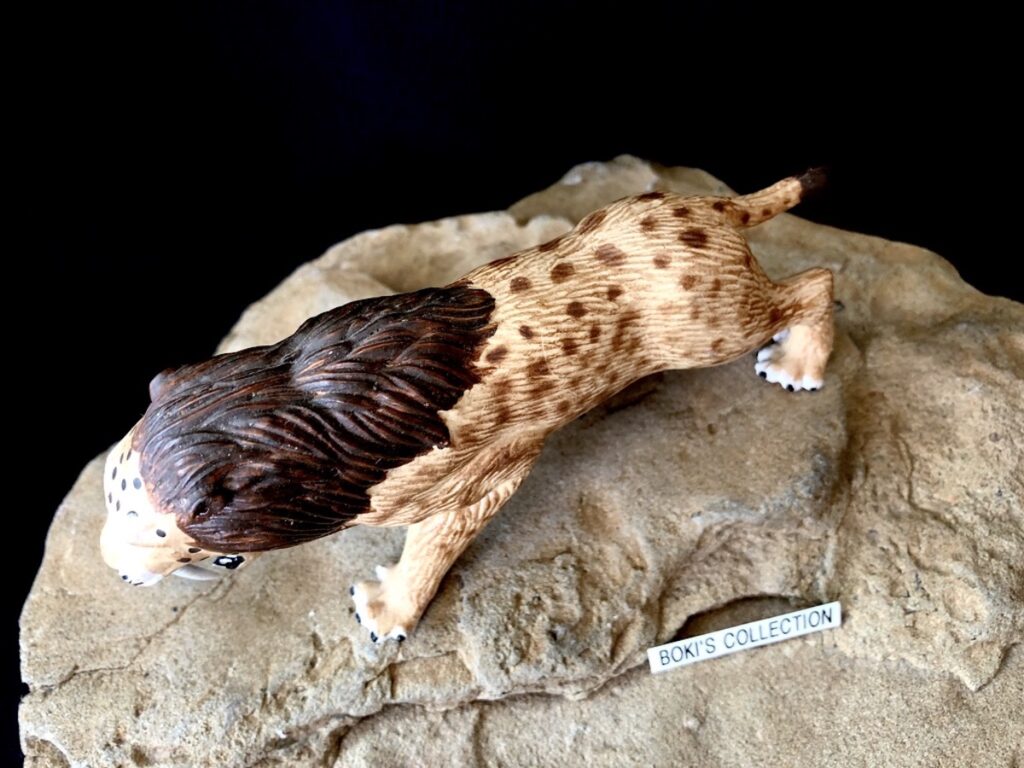
Okay, so what was the exception I was talking about? If you look at the illustration of Smilodon in the book, the overall body color is pretty close with light brown body, dark brown mane, and some white that highlights the paws, muzzle, and chest areas of the body.The big difference is that in the illustration, there are no spots seen anywhere on the body. But as you can see, the figure has spots all over the body and face as well as legs.
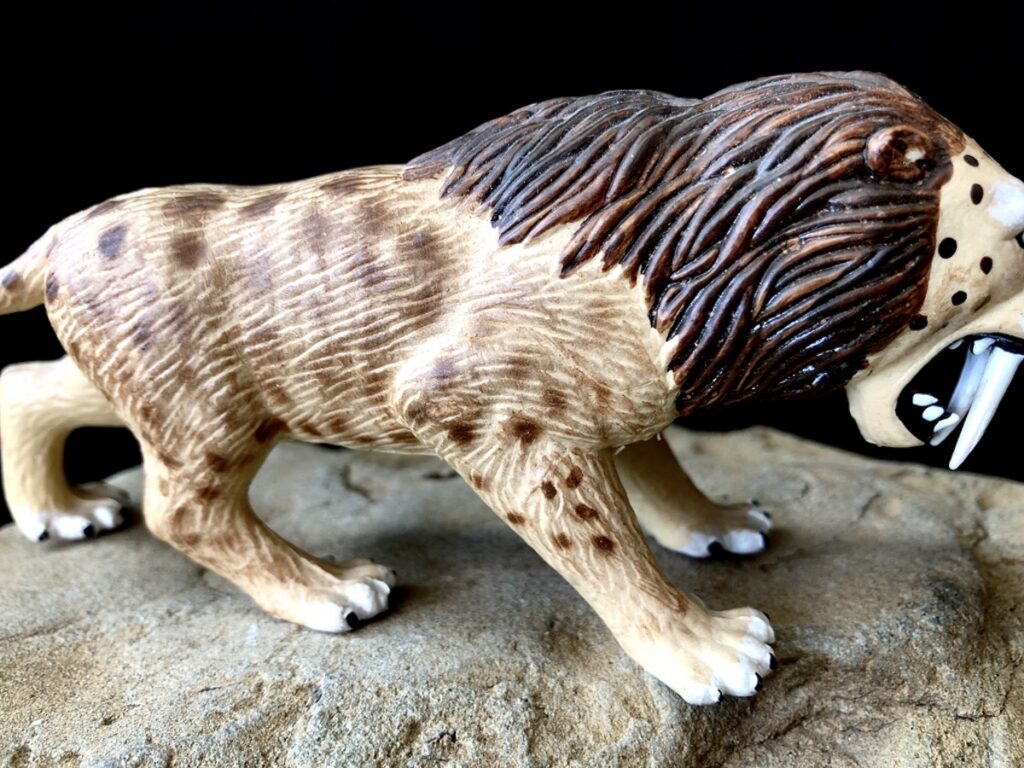
Now ,look at the book page with all the illustration again and notice the Homotherium. See how it is decked out in spots of various sizes all over its body, which the figure resembles. So, it really looks like they took some designs from both illustration and combined it on this figure, which worked and gave it a little bit more character than if given the standard brown like a lion.
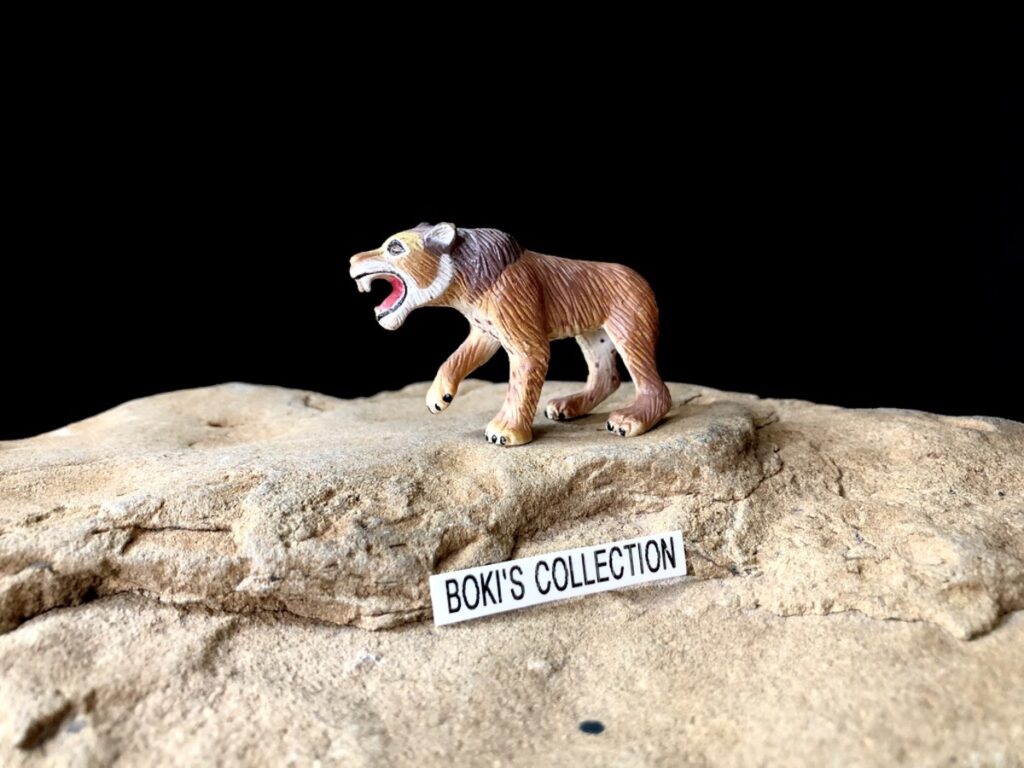
Even more puzzling is that the “supposed min version” of Smilodon looks totally different from the large one and is clearly based on the Homotherium illustration in the book minus the spots.So, in reality, the mini version should really be a Homotherium, a much smaller cat and very rare in the toy figure world, I’m not even sure there is one out there. Homotherium had a much wider worldwide distribution than Smilodon and was around the size of today’s lions. They are contemporary of Smilodon and had some overlap in their range, although Homotherium was rarer is is believed to have inhabited much higher altitude.
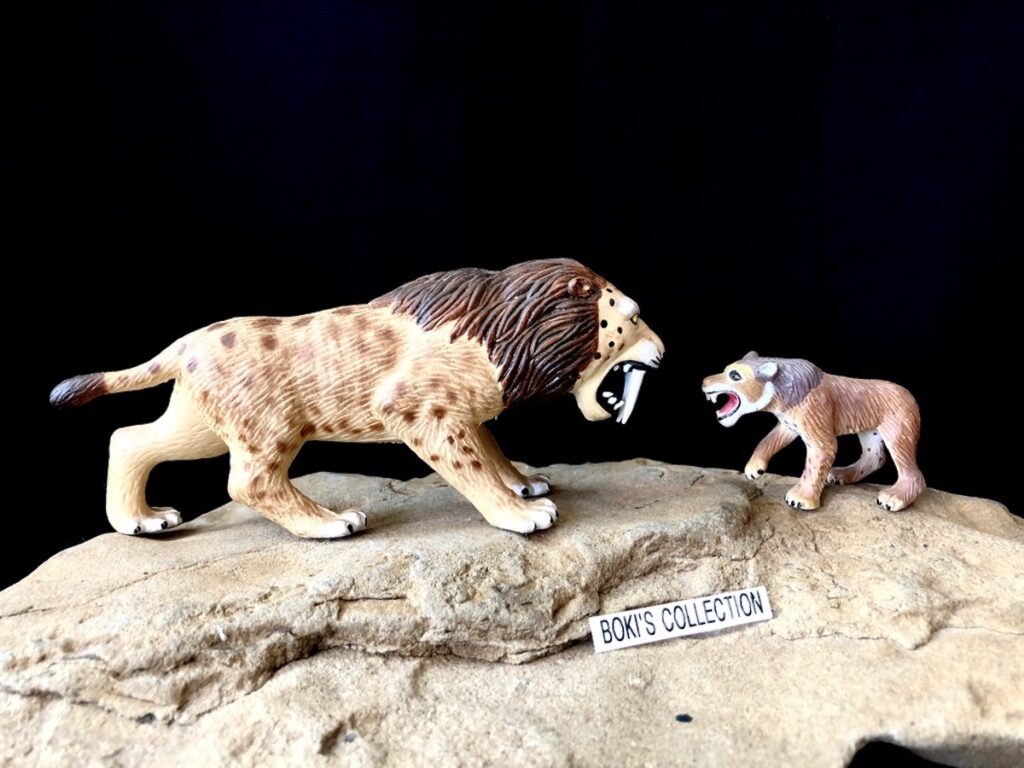
Why they decided to name this little guy Smilodon I don’t know. It could be that they wanted something that is well known, but that really doesn’t make sense when you look at the species list from the small set, where there are some truly obscure ones.It’s possible that they wanted something else different for the mini set and thought no one will notice. We may never know the true reasoning of why 2 of the mini versions that had large version are totally different from each other, while the other two are perfect replica.
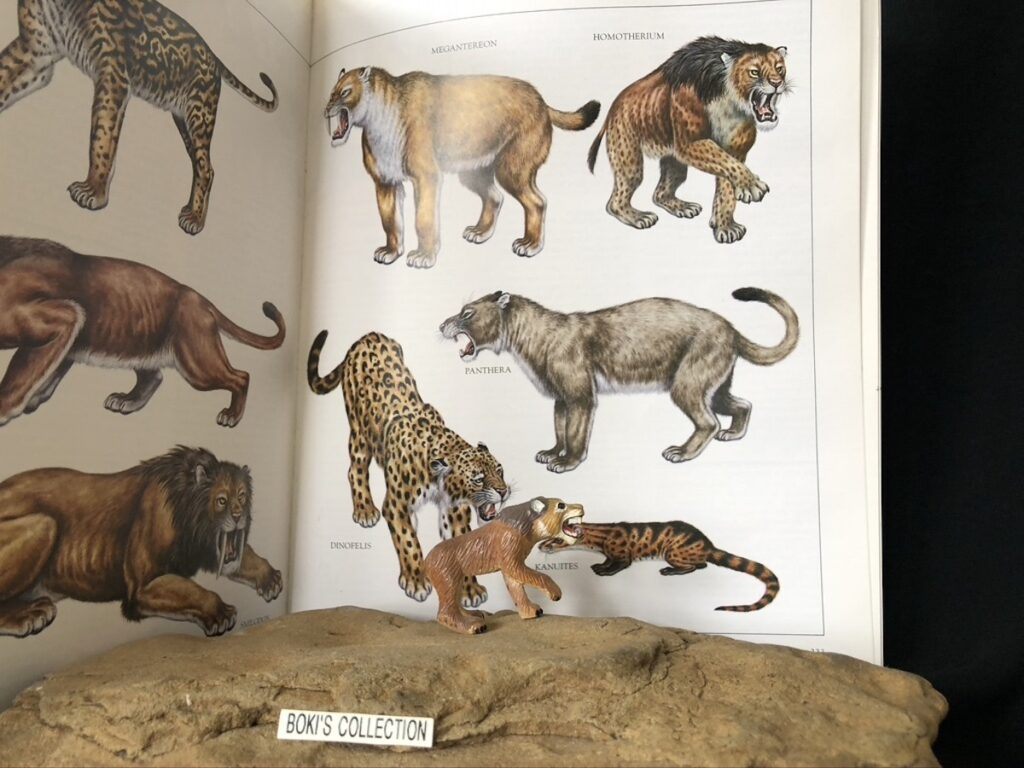
Rarity aside, there really is nothing exceptional about this particular figure. That being said, it is still a nice representation or record of what was once commonly held belief of what male Smilodon may have looked like. And if you have appreciation or care about toy history, this set is also a good representation of something that was fleeting and have sent collectors on a hunt, there is no doubt of their collector and sentimental value will only increase with time.
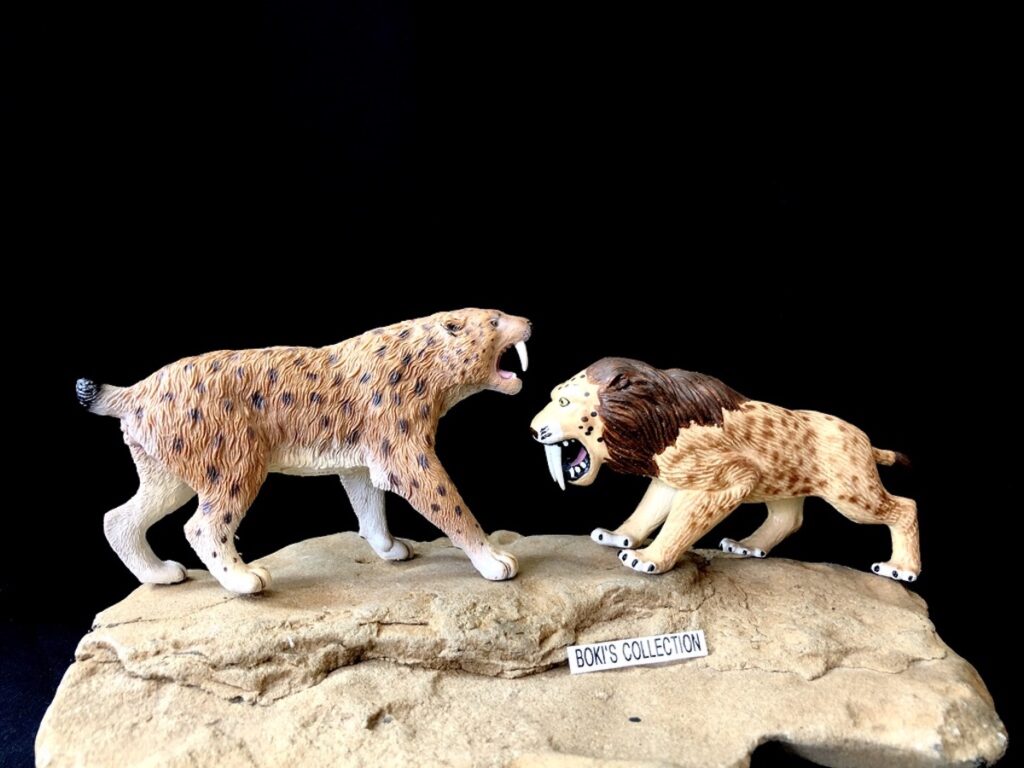
If accuracy is your thing, then this is definitely a figure that won’t make the cut into your collection, there are many other more accurate figures out there. I find the figure charming and full of character despite its shortcomings. Of the four large figures in the set, this is the most common and least expensive ($30-40 dollars the last time I saw one) of them. You can find it more easily than the other three on ebay.Unlike the small prehistoric amphibian and marine reptiles that were re-released for a very short time a few years back, these large mammals were not as far as I know of.
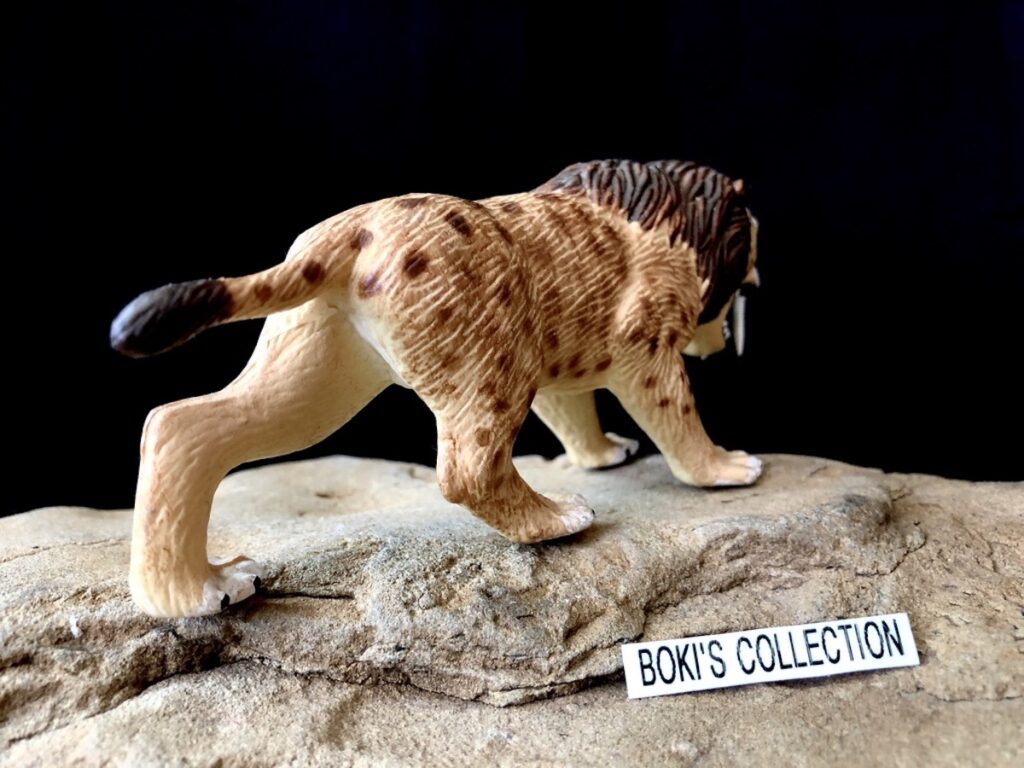
In today’s quest for the most accurate and high-production qualities in toy figures, I find it refreshing to have something from the bygone era, where simplicity was enough to give one great joy. This figure definitely fits that category and is well worth acquire for sentimental value, if nothing else.
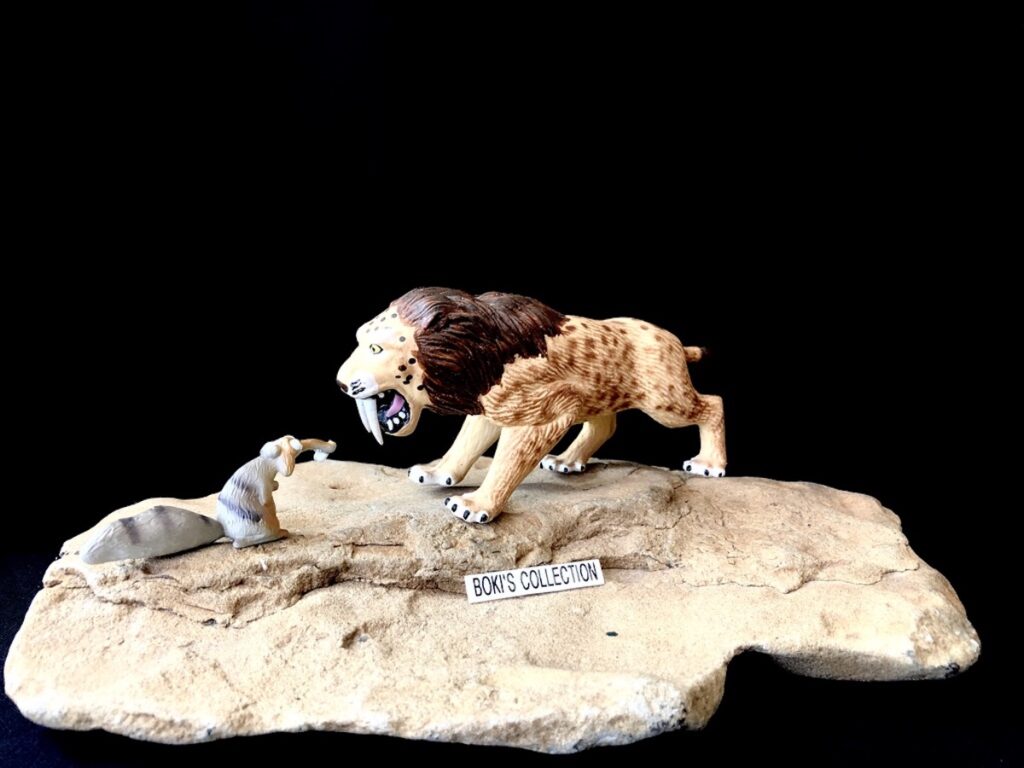
To this day, it still maintains a special place in my collection despite the many, more accurate figures available.I hope you all like the review. On part 2 we will take a look at the figure that really caught my eyes in that store that would lead me years later on a quest to find it.
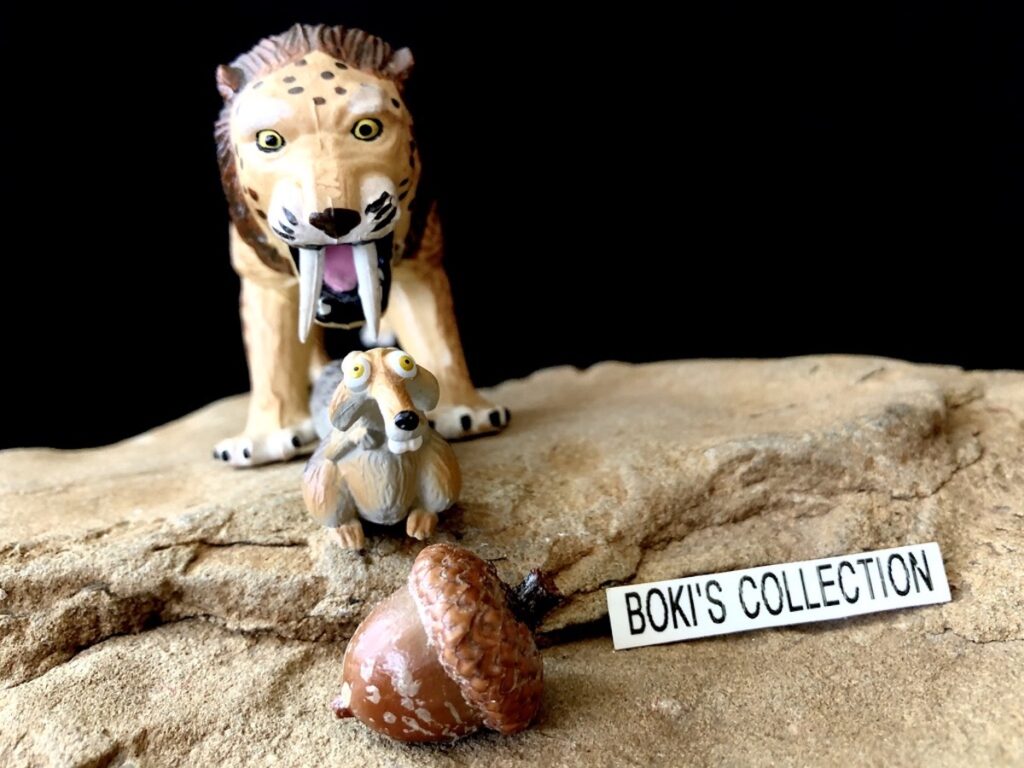
Until then, stay safe and healthy, Cheers!
Disclaimer: links to Ebay and Amazon on the DinoToyBlog are affiliate links, so we make a small commission if you use them. Thanks for supporting us!




i remember checking this book out many times i tried to like the mane on the smilodon but i like the charles r knight image better
The smilodon is perhaps the weakest figure in the Play Visions group of large mammals. However, it has its charm, especially the spots on the body as if it were a leopard or a cheetah, nevertheless they give a primitive and attractive image to this megacarnivore of the Ice Age. However the less fortunate part is the head, however it appears with a challenging and dynamic posture with those slightly bent legs and that roaring open mouth makes excuses for that Play Visions mistake. It is by far the easiest figure to find in eBay stores.
Leaving this opinion expressed in the forum, I congratulate Bokisaurus for his successful and interesting article in which I consider myself a loyal follower of both his opinions and his thread in the DTF.